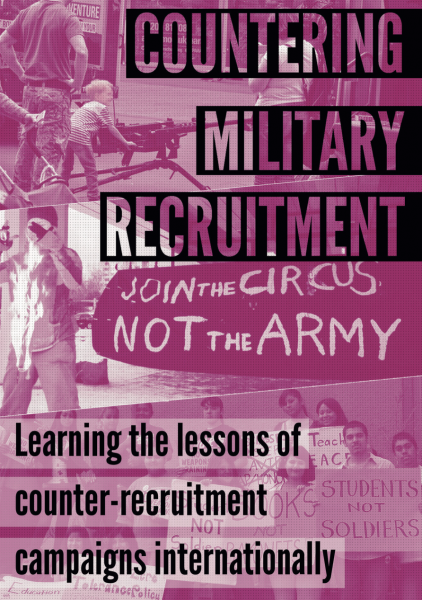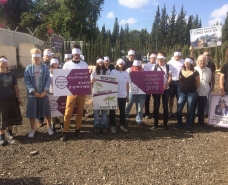Youth Resistance in the Mariana Islands: Protecting sacred sites from the United States Military

By Sylvia C. Frain, the National Centre for Peace and Conflict Studies, University of Otago
The United States Department of Defence (DOD) currently utilizes over 30 million acres of land at more than 5,000 different locations around the world. These military bases and colony units are often-overlooked aspects of the United States (U.S.) global military footprint.
The Mariana Island archipelago in the Western Pacific, 8,950 miles from Washington D.C. and the Pentagon, is one such location. Guåhan (Guam), the largest and most southern of the Mariana Islands, is an unincorporated territory of the U.S. Nearly onethird of the island is a restricted strategic base for all branches of the American military and the U.S. Constitution does not apply in full. Residents are second-class U.S. citizens without political representation in U.S. Congress and cannot vote for President. According to the United Nations Special Committee on the ‘Situation with regard to the Implementation of the Declaration on the Granting of Independence to Colonial Countries and Peoples’, Guåhan is a possession but not part of the United States.
Despite being part of the same archipelago as Guåhan, the remaining 14 Mariana Islands are politically structured as the Commonwealth of the Northern Mariana Islands (CNMI), which is bound to the Convent (contract) with the U.S. The DOD conducts training and testing within the Mariana Island Range Complex (MIRC), a 501,873 nautical mile range that is three times the size of California, and one of the largest DOD ranges in the world. In addition to the land the military occupies, it is estimated that at least one in eight Mariana residents are currently serving or have served in the United States Armed Forces. They have fought for ‘democracy’ and ‘freedom’ in America’s foreign wars at rates three times higher than any other State or Territory in the U.S.
This colonial relationship with the U.S. in which the entire Mariana Archipelago are considered U.S. ‘sovereign soil’, directly allows for the current militarization as well as the planned Pacific Pivot ‘build-up’. The DOD has proposed relocating thousands of Marines from Okinawa, Japan and the construction of live firing range complexes on sacred land while ‘leasing’ entire islands as bombing targets. Therefore, resistance is happening as an effort to change the current colonial political status, while also resisting the increased militarization by the DOD.
Resistance to colonial status
Self-determination & Unification of the Marianas
Young people have watched generations of politicians and activists testify before the U.S. Congress and the United Nations to appeal for true self-determination. They understand that U.S. Federal Agencies, including the Department of Insular Affairs, is not going to assist in the process for self-determination. Therefore, young people feel that other avenues and methods must be used. Through social media and nonviolent resistance they continue to tackle colonization through re-educating and informing people that they have a choice for political representation. The three options for political status include: Statehood, Free Association, or Independence.
The division between Guåhan and the rest of the Northern Marianas is a remnant of colonial rule and the call to end the ‘imperial meridian’ (see clip of attorney and author, Julian Aguon,) and reunite Guåhan and the Northern Marianas as One Marianas is central to the political status and resistance activities. Young women from Guåhan used YouTube to show their solidary with the CNMI. In 2015 students created a video for their History and Culture of Guåhan class, and wrote, “the United States military has made plans to use our islands as living firing ranges without consulting the indigenous people that inhabit these precious islands” (See https://youtu.be/bL5yDV0IZtQ).
Resistance to Militarization
World War II
When discussing the continual militarisation of the Marianas, it is important to note that World War II has not ended for the people of the Marianas, particularly on Guåhan. Reminders are passed down from generation to generation with numerous families still waiting for promised war reparations and the return of their lands that were taken by the military shortly after WWII. The United States returned to Guåhan in 1944 to ‘liberate’ it from the Japanese, and took land for military installations, beaches for recreation and farmland for golf courses. Today the DOD continues to have jurisdiction over nearly 30% of the island and these families still have not received proper compensation. Many are skeptical of the ‘benefits’ of the proposed build-up that the military is promising because of these unresolved issues from World War II.
Environmental Impact Statements (EIS)
While the military maintains that it is available to ‘listen to people’s concerns’, the manner in which the DOD ‘interacts’ with the community is one-sided and culturally impropriate within a Pacific Islander context. The ‘public hearings’ are organized and managed by the military personnel, who are often in uniform and present a slick marketing campaign with posters and power points. They only allow for 3-minute statements from the public and there is no accountability for the way the DOD incorporates community concerns. Over the last 5 years, five EIS documents, (each costing around $25 million) containing thousands of pages of highly technical military terminology have been released, giving the community only 30- 60 days to respond. To the young people, it is as if the DOD is relying on resistance ‘fatigue’ by continuously releasing documents.
Even when young activists of Our Islands Are Sacred (OIAS) network were able organize 10,000 written comments in 2010, the mainstream media either ignored or discredited this accomplishment. Today OIAS and We Are Guåhan continue to use social media and other forms of cultural, artistic resistance to address each subsequent DOD EIS.
Sexual Assault
Women are especially concerned because of the relocation of 18-25 year old Marines, who will be on the island for 6-month rotations. The Marines are being relocated from Okinawa because of the high levels of drunkenness, sexual assault and violence towards the local community. On Guåhan, human trafficking is already a problem, (see Madam Facebook page) and over 200 massage parlours exist for the current military (and tourism) industry. The DOD or politicians who are pushing for the build-up have not addressed these impacts.
Protecting Sacred Land
The demilitarisation movement is currently focused on protecting sacred sites from being used as live firing ranges. Similar to other activists in Oceania, such as the Protectors of Mauna Kea, and the kayakvists in the Port of Seattle, the young people here are working to preserve two islands in the Northern Marianas; Pågan and Tinian, and two scared sites on Guåhan, Litekyan (Riditian) and Pågat that include 4,000 year old settlements, cave paintings and latte stones. The online petition has gained over 113,000 signatures. Please continue to sign and share!
Online Resistance
Young people across the Mariana archipelago continue to resist the U.S. contemporary colonization and everyday militarization of their islands through artistic channels and social media. They are writing plays, novels, poetry and are producing online ‘zines’, and blogs to decolonize and demilitarise their islands.
Facebook groups and forms include:
-
We Are Guahan, a community page;
-
Manhita Marianas- Marianas Together, public group;
For more information and ways to show your solidarity, visit the Facebook page:
Oceania Resistance or email Sylvia.Frain@postgrad.otago.ac.nz.
Countering Military Recruitment

WRI's new booklet, Countering Military Recruitment: Learning the lessons of counter-recruitment campaigns internationally, is out now. The booklet includes examples of campaigning against youth militarisation across different countries with the contribution of grassroot activists.
You can order a paperback version here.








